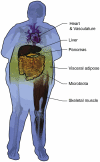Cellular senescence: Implications for metabolic disease
- PMID: 27591120
- PMCID: PMC5857952
- DOI: 10.1016/j.mce.2016.08.047
Cellular senescence: Implications for metabolic disease
Abstract
The growing burden of obesity- and aging-related diseases has hastened the search for governing biological processes. Cellular senescence is a stress-induced state of stable growth arrest strongly associated with aging that is aberrantly activated by obesity. The transition of a cell to a senescent state is demarcated by an array of phenotypic markers, and leveraging their context-dependent presentation is essential for determining the influence of senescent cells on tissue pathogenesis. Biomarkers of senescent cells have been identified in tissues that contribute to metabolic disease, including fat, liver, skeletal muscle, pancreata, and cardiovascular tissue, suggesting that pharmacological and behavioral interventions that alter their abundance and/or behavior may be a novel therapeutic strategy. However, contradictory findings with regard to a protective versus deleterious role of senescent cells in certain contexts emphasize the need for additional studies to uncover the complex interplay that defines multi-organ disease processes associated with obesity and aging.
Keywords: Aging; Diabetes; Exercise; Inflammation; Obesity; Senolytics.
Copyright © 2016 Elsevier Ireland Ltd. All rights reserved.
Figures



Similar articles
-
Targeting senescent cells alleviates obesity-induced metabolic dysfunction.Aging Cell. 2019 Jun;18(3):e12950. doi: 10.1111/acel.12950. Epub 2019 Mar 25. Aging Cell. 2019. PMID: 30907060 Free PMC article.
-
Senolytics decrease senescent cells in humans: Preliminary report from a clinical trial of Dasatinib plus Quercetin in individuals with diabetic kidney disease.EBioMedicine. 2019 Sep;47:446-456. doi: 10.1016/j.ebiom.2019.08.069. Epub 2019 Sep 18. EBioMedicine. 2019. PMID: 31542391 Free PMC article.
-
Senolytic drugs, dasatinib and quercetin, attenuate adipose tissue inflammation, and ameliorate metabolic function in old age.Aging Cell. 2023 Feb;22(2):e13767. doi: 10.1111/acel.13767. Epub 2023 Jan 13. Aging Cell. 2023. PMID: 36637079 Free PMC article.
-
Cellular Senescence in Diabetes Mellitus: Distinct Senotherapeutic Strategies for Adipose Tissue and Pancreatic β Cells.Front Endocrinol (Lausanne). 2022 Mar 31;13:869414. doi: 10.3389/fendo.2022.869414. eCollection 2022. Front Endocrinol (Lausanne). 2022. PMID: 35432205 Free PMC article. Review.
-
Molecular basis of ageing in chronic metabolic diseases.J Endocrinol Invest. 2020 Oct;43(10):1373-1389. doi: 10.1007/s40618-020-01255-z. Epub 2020 May 1. J Endocrinol Invest. 2020. PMID: 32358737 Free PMC article. Review.
Cited by
-
Effect of Cellular Senescence in Disease Progression and Transplantation: Immune Cells and Solid Organs.Transplantation. 2024 Jul 1;108(7):1509-1523. doi: 10.1097/TP.0000000000004838. Epub 2023 Nov 13. Transplantation. 2024. PMID: 37953486 Review.
-
The Mechanism of Bone Remodeling After Bone Aging.Clin Interv Aging. 2022 Apr 5;17:405-415. doi: 10.2147/CIA.S349604. eCollection 2022. Clin Interv Aging. 2022. PMID: 35411139 Free PMC article. Review.
-
The role of cellular senescence in ageing and endocrine disease.Nat Rev Endocrinol. 2020 May;16(5):263-275. doi: 10.1038/s41574-020-0335-y. Epub 2020 Mar 11. Nat Rev Endocrinol. 2020. PMID: 32161396 Free PMC article. Review.
-
Targeting Premature Renal Aging: from Molecular Mechanisms of Cellular Senescence to Senolytic Trials.Front Pharmacol. 2021 Apr 29;12:630419. doi: 10.3389/fphar.2021.630419. eCollection 2021. Front Pharmacol. 2021. PMID: 33995028 Free PMC article. Review.
-
Senolytic treatment reverses obesity-mediated senescent cell accumulation in the ovary.Geroscience. 2022 Jun;44(3):1747-1759. doi: 10.1007/s11357-022-00573-9. Epub 2022 Apr 23. Geroscience. 2022. PMID: 35460445 Free PMC article.
References
-
- Acosta JC, O'Loghlen A, Banito A, Guijarro MV, Augert A, Raguz S, Fumagalli M, Da Costa M, Brown C, Popov N, Takatsu Y, Melamed J, d'Adda di Fagagna F, Bernard D, Hernando E, Gil J. Chemokine signaling via the CXCR2 receptor reinforces senescence. Cell. 2008;133:1006–1018. - PubMed
-
- Acosta JC, Banito A, Wuestefeld T, Georgilis A, Janich P, Morton JP, Athineos D, Kang TW, Lasitschka F, Andrulis M, Pascual G, Morris KJ, Khan S, Jin H, Dharmalingam G, Snijders AP, Carroll T, Capper D, Pritchard C, Inman GJ, Longerich T, Sansom OJ, Benitah SA, Zender L, Gil J. A complex secretory program orchestrated by the inflammasome controls paracrine senescence. Nat. cell Biol. 2013;15:978–990. - PMC - PubMed
-
- Al-Aubaidy HA, Jelinek HF. Oxidative DNA damage and obesity in type 2 diabetes mellitus. Eur. J. Endocrinol./Eur. Fed. Endocr. Soc. 2011;164:899–904. - PubMed
Publication types
MeSH terms
Substances
Grants and funding
LinkOut - more resources
Full Text Sources
Other Literature Sources
Medical

